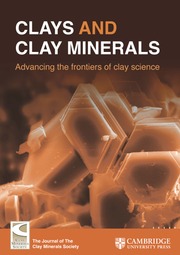Article contents
Adsorption of a C10E3 non-ionic surfactant on a Ca-smectite
Published online by Cambridge University Press: 01 January 2024
Abstract
The transformation of clay minerals into organo-clays by surfactant intercalation is of great environmental and industrial importance because it causes the clay to attract hydrophobic contaminants and other non-polar organic compounds, but a better understanding is needed of the mechanisms by which different classes of surfactants are intercalated. The purpose of this study was to synthesize and characterize an organo-clay comprising triethylene glycol monodecyl ether (C10E3) non-ionic surfactant, which has a lamellar phase at room temperature, intercalated into Ca-montmorillonite from Wyoming (SWy-2). The C10E3 non-ionic surfactant differed from previous non-ionic surfactants used in the formation of a lamellar phase in that it consisted of the stacking of molecules by hydrophobic interaction. C10E3-clay composites were characterized by complementary techniques (adsorption isotherms, X-ray diffraction, and infrared spectroscopy) and were compared to benzyldimethyltetradecyl ammonium chloride (BDTAC) cationic surfactant-clay composites for different loadings of the surfactant. For large loadings, the amount of C10E3 adsorbed, which can be described by the Langmuir equation, seemed to reach a steady state close to that of the cationic surfactant. The adsorption processes of the two surfactants were different. For the cationic surfactant, the adsorption, as described in the literature, was due to ion exchange between organic cations and Ca2+ counterions. The adsorption of C10E3 did not depend on electrostatic interaction but rather was due to several interaction mechanisms (H-bonding, ion-dipole, and hydrophobic interaction). For both surfactants, the expansion was limited to two adsorbed monolayers parallel to the clay surface. The expansion of the basal spacing to 17 Å suggested a complete dissociation of the C10E3 lamellar phase when adsorbed on the Ca-smectite. Organo-clays made using the non-ionic surfactant were stable, changing the chemical nature of clay to hydrophobic, and allowing for other cations to be exchanged, which has importance in the manufacture of new nanocomposites or geochemical barriers.
Information
- Type
- Article
- Information
- Copyright
- © The Clay Minerals Society 2009
References
- 25
- Cited by

